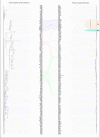Molecular epidemiology of Salmonella Infantis in Europe: insights into the success of the bacterial host and its parasitic pESI-like megaplasmid
- PMID: 32271142
- PMCID: PMC7371121
- DOI: 10.1099/mgen.0.000365
Molecular epidemiology of Salmonella Infantis in Europe: insights into the success of the bacterial host and its parasitic pESI-like megaplasmid
Abstract
Salmonella Infantis is one of the five serovars most frequently causing human salmonellosis in Europe, mainly associated with poultry. A clone harbouring a conjugative plasmid of emerging S. Infantis (pESI)-like megaplasmid, carrying multidrug resistant (MDR) and extended-spectrum beta-lactamases (ESBL) genes, has spread in the Italian broiler chicken industry also causing human illness. This work is aimed at elucidating the molecular epidemiology of S. Infantis and pESI-like in Europe using whole-genome sequencing and bioinformatics analysis, and to investigate the genetic relatedness of S. Infantis clones and pESI-like from animals, meat, feed and humans provided by institutions of nine European countries. Two genotyping approaches were used: chromosome or plasmid SNP-based analysis and the minimum spanning tree (MST) algorithm based on core-genome multilocus sequence typing (cgMLST). The European S. Infantis population appeared heterogeneous, with different genetic clusters defined at core-genome level. However, pESI-like variants present in 64.1 % of the isolates were more genetically homogeneous and capable of infecting different clonal lineages in most of the countries. Two different pESI-like with ESBL genes (n=82) were observed: blaCTX-M-1-positive in European isolates and blaCTX-M-65-positive in American isolates (study outgroup). Both variants had toxin-antitoxin systems, resistance genes towards tetracyclines, trimethoprim, sulphonamides and aminoglycosides, heavy metals (merA) and disinfectants (qacEΔ). Worryingly, 66 % of the total isolates studied presented different gyrA chromosomal point mutations associated with (fluoro)quinolone resistance (MIC range 0.125-0.5 mg/L), while 18 % displayed transferable macrolide resistance mediated by mph, mef and erm(B) genes. Proper intervention strategies are needed to prevent further dissemination/transmission of MDR S. Infantis and pESI-like along the food chain in Europe.
Keywords: ESBL (Extended Spectrum Beta-Lactamases); Salmonella Infantis; megaplasmids; multidrug resistance; pESI-like; whole genome sequencing.
Conflict of interest statement
The authors declare that there are no conflicts of interest.
Figures




References
-
- Franco A, Leekitcharoenphon P, Feltrin F, Alba P, Cordaro G, et al. Emergence of a clonal lineage of multidrug-resistant ESBL-producing Salmonella Infantis transmitted from broilers and broiler meat to humans in Italy between 2011 and 2014. PLoS One. 2015;10:e0144802. doi: 10.1371/journal.pone.0144802. - DOI - PMC - PubMed
Publication types
MeSH terms
LinkOut - more resources
Full Text Sources
Medical

